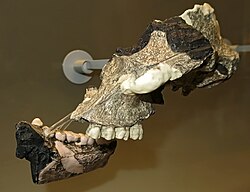Paranthropus robustus
Paranthropus robustus was originally discovered in Southern Africa in 1938. The development of P. robustus, namely in cranial features, seemed to be aimed in the direction of a "heavy-chewing complex". Because of the definitive traits that are associated with this robust line of australopithecine, anthropologist Robert Broom erected the genus Paranthropus and placed this species into it.
| Paranthropus robustus Temporal range: Pliocene-Pleistocene
| |
|---|---|

| |
| Original Skull of Paranthropus robustus at the Transvaal Museum | |
| Scientific classification | |
| Kingdom: | |
| Phylum: | |
| Class: | |
| Order: | |
| Family: | |
| Subfamily: | |
| Genus: | |
| Species: | P. robustus
|
| Binomial name | |
| †Paranthropus robustus Broom, 1938
| |
Paranthropus Robustus Media
Cast of the face of TM 1517, the holotype specimen of P. robustus
OH 5 (reconstructed skull above) was made the holotype specimen of the second Paranthropus species, P. boisei.
P. robustus could have lived in multi-male groups like Hamadryas baboons (above troop at Dierenpark Emmen).
The left upper 1st molar of SK 57 with tertiary dentin (white arrow)
Ronald J. Clarke suggested StW 505 (above) is ancestral to P. robustus.
GDA-2 from Gondolin Cave









